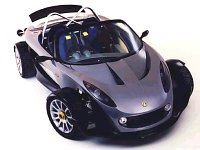 It’s
so long we haven’t seen a Lotus whose name without starting from "E".
The
last one was Seven, which evacuated from Lotus price list in 1973.
Interestingly,
the new 340R is intended to be a modern Seven. In other words, it’s a
minimalist
that prefer weekend race activities more than daily use. It’s
so long we haven’t seen a Lotus whose name without starting from "E".
The
last one was Seven, which evacuated from Lotus price list in 1973.
Interestingly,
the new 340R is intended to be a modern Seven. In other words, it’s a
minimalist
that prefer weekend race activities more than daily use.
Really, it looks somewhat like a Formula racing car, with exposed wheels and front air foils at either side of the nose. No roof, no soft top, zero rain protection at all. Although there is a windscreen (unlike formula racing cars), it’s not high enough to eliminate buffeting to the cockpit, so it’s better to wear helmet.
Technical View
On the other hand, it has 34 more horsepowers than Elise 111S, thanks to an engine modified from the 190 hp Single-Vehicle-Approved-only Elise Sport. The 1775 c.c. four pot was derived from the standard Rover K-series rather than VVC unit, but it has higher compression ratio and various modifications to improve breathing, plus an aggressive computer mapping. Although the 177 hp maximum output and 126 lbft of torque cannot match the Elise Sport, it fully complies with EU’s noise and emission regulations. As a result, the 340R has obtained EU’s type approval and could be sold to any EU member countries without limited number, although Lotus decided to build only 340 units to ensure desirability. Apart from the number of production, interesting, the name 340R was also intended to represent the power-to-weight ratio. However, because the car turned out to be a bit heavier and a bit less powerful than desired, it is now just 295 hp / ton. The race track version, on the other hand, with catalyst removed and reprogrammed to restore the 190 hp output, and striped out to 568 kg, just miss the target by 5 hp / ton. On the road Despite of the vast increase of power-to-weight ratio, the 340R still isn’t as lightning as our crazy Caterham R500 or Westfield FW400 - these cars are 400-460 kg and have 190 hp on tap, no match by the 340R. In fact, drive it normally, it feels more similar to the Elise 111S. Below 4,000 rpm, its weight advantage over the Elise is offset by the VVC engine’s flexibility. Above that, the 340R starts getting into live. It roars harder, spins stronger towards the 7,600 rpm redline while delivering the extra punch over the Elise. 0-60 of 4.4 sec might be a bit optimistic (4.7 could be more believable), but it is undoubtedly at least 0.7 seconds quicker than any road-going Elise. Likewise, the 140 mph top speed is also doubtful because of inefficient aerodynamic design, but no one will buy this kind of cars for autobahn cruising.
As long as the sky is clear, 340R is the best tool to enjoy driving fun. It has the same superb steering feel and throttle steer ability as Elise. In addition of that, it has more power and more grip to explore higher level of cornering limit. Braking can hardly be better. Compare with Caterham or Westfield, it is more secure to drive fluently, without scaring your passenger. And ride quality is first class (even comparable to many warm coupes). It’s stylish and more like a consumer product than a kit car too. Anyway,
nightmare could be happened if the sky start raining after driving long
away home. At shower, the only technique to avoid wetting your hair is
to drive faster, fast enough that the rain drops are deflected from the
windscreen. Unluckily, the Yokohama rubbers seemed unhappy with wet. At
pouring, you’d better to look for sheltering, unless you’d like to have
a cold water bath ! |
| The above report was last updated on 26 Apr 2000. All Rights Reserved. |
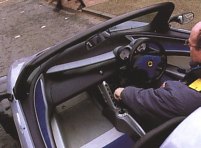 The
cockpit makes an Elise seemed nearly luxurious. Firstly, there is no
door.
To enter, sit on the glass-fiber bodywork, swing your legs into the
footwell
one by one. Well done, doing this everyday could save your gymnastic
club
membership fee. After settling on the racing bucket, you’ll find a
stylish
yet simple layout. Like its chassis donor, Elise, the floor and sills
are
simply the exposed surfaces of the aluminium chassis. There’s no
equipment
at all, such as radio, air-conditioning, window (yes, no window, let
alone
electric or not), carpet ... instead, there are a lot of concept
car-like
styling features to deliver a sense of occasion. Like Elise (or any
Ferrari),
the gear knob is an aluminium globe, but the 340R has more stylish
alloy
decoration, such as the rim surrounding the base of shifter lever and
the
whole handbrake. More eye-catching is the twin white-faced gauges
suspended
in the air by an arc of plastic moulding, very stylish. Underneath the
plastic dash is a thin aluminium blade vertically runs down to the
shifter.
That’s 340R’s center console, which houses virtually all the control
buttons
available. Lastly, 340R also differs from any other road car by
offering
a transparent composite panel covering what would have been the middle
of the door (that’s between the upper body work and the aluminium
chassis
sill). The original show car had that place exposed to air, but it was
found too drafty.
The
cockpit makes an Elise seemed nearly luxurious. Firstly, there is no
door.
To enter, sit on the glass-fiber bodywork, swing your legs into the
footwell
one by one. Well done, doing this everyday could save your gymnastic
club
membership fee. After settling on the racing bucket, you’ll find a
stylish
yet simple layout. Like its chassis donor, Elise, the floor and sills
are
simply the exposed surfaces of the aluminium chassis. There’s no
equipment
at all, such as radio, air-conditioning, window (yes, no window, let
alone
electric or not), carpet ... instead, there are a lot of concept
car-like
styling features to deliver a sense of occasion. Like Elise (or any
Ferrari),
the gear knob is an aluminium globe, but the 340R has more stylish
alloy
decoration, such as the rim surrounding the base of shifter lever and
the
whole handbrake. More eye-catching is the twin white-faced gauges
suspended
in the air by an arc of plastic moulding, very stylish. Underneath the
plastic dash is a thin aluminium blade vertically runs down to the
shifter.
That’s 340R’s center console, which houses virtually all the control
buttons
available. Lastly, 340R also differs from any other road car by
offering
a transparent composite panel covering what would have been the middle
of the door (that’s between the upper body work and the aluminium
chassis
sill). The original show car had that place exposed to air, but it was
found too drafty. 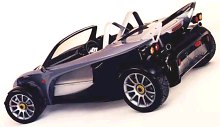 Likewise,
the exterior styling looks more like a concept car than a EU-approved
road
car. The glass-fiber bodywork is very complicated in shape, delivering
an aggressive and purposeful feeling. Aggressiveness come from
twin-plane
front spoilers, exposed wheels and suspensions, a lot of
aggressive-shape
ventilation holes and cooling ducts, exposed exhaust silencer and the
high
angle rear spoiler held by aluminium frames. Style came from ecliptic
headlights,
chromed exhaust pipes mounted at unusually high level, 4 suspended
circular
rear lights and a McDonald-inspired twin rollover protection bar.
Overall
speaking, is it beautiful? I don’t think so, although it is undeniably
one of the most spectacular cars on road.
Likewise,
the exterior styling looks more like a concept car than a EU-approved
road
car. The glass-fiber bodywork is very complicated in shape, delivering
an aggressive and purposeful feeling. Aggressiveness come from
twin-plane
front spoilers, exposed wheels and suspensions, a lot of
aggressive-shape
ventilation holes and cooling ducts, exposed exhaust silencer and the
high
angle rear spoiler held by aluminium frames. Style came from ecliptic
headlights,
chromed exhaust pipes mounted at unusually high level, 4 suspended
circular
rear lights and a McDonald-inspired twin rollover protection bar.
Overall
speaking, is it beautiful? I don’t think so, although it is undeniably
one of the most spectacular cars on road. 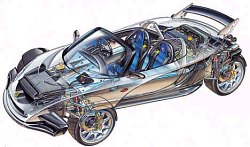 It’s
essentially an Elise with more power and less weight. The aluminium
chassis
is pure Elise, but the minimalist body work, lean cockpit, no roof, no
window, cut-down windscreen etc. reduce the dry weight to a claimed 600
kg. Transferred to a kerb weight, it becomes 675 kg, about 100 kg
lighter
than Elise 111S.
It’s
essentially an Elise with more power and less weight. The aluminium
chassis
is pure Elise, but the minimalist body work, lean cockpit, no roof, no
window, cut-down windscreen etc. reduce the dry weight to a claimed 600
kg. Transferred to a kerb weight, it becomes 675 kg, about 100 kg
lighter
than Elise 111S. 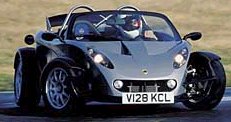 Surprisingly,
despite of its lightweight, the 340R also display very well road
manner.
It’s grippy and stable at the limit, without the uncontrollable feeling
of other super lightweights. Undoubtedly, the larger section tyres
specially
designed by Yokohama play an important roles in handling. They have
fewer
grooves than normal road tyres and more like racing slick, thus provide
massive grip as well as meaty steering feel. The rear ones are 225/45
ZR16,
like Elise 111S, make it less tail-happy than the standard Elise. This
is very crucial to the 340R, as it corners faster and harder than any
Elise,
and is more responsive in any situation. Stiffer suspensions, more
downforce
from the big rear spoiler and ground effect rear diffuser also raise
its
cornering ability.
Surprisingly,
despite of its lightweight, the 340R also display very well road
manner.
It’s grippy and stable at the limit, without the uncontrollable feeling
of other super lightweights. Undoubtedly, the larger section tyres
specially
designed by Yokohama play an important roles in handling. They have
fewer
grooves than normal road tyres and more like racing slick, thus provide
massive grip as well as meaty steering feel. The rear ones are 225/45
ZR16,
like Elise 111S, make it less tail-happy than the standard Elise. This
is very crucial to the 340R, as it corners faster and harder than any
Elise,
and is more responsive in any situation. Stiffer suspensions, more
downforce
from the big rear spoiler and ground effect rear diffuser also raise
its
cornering ability.